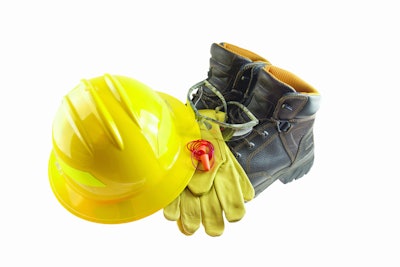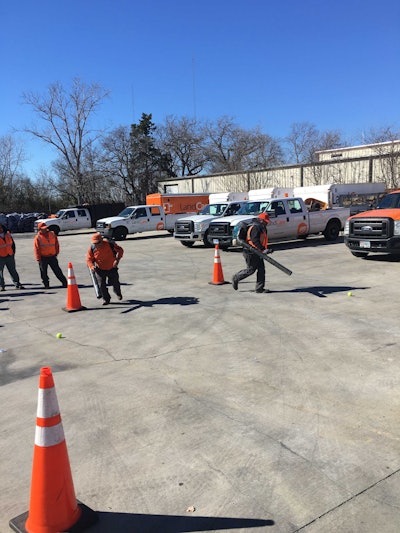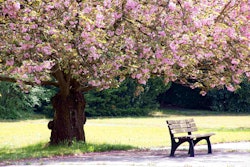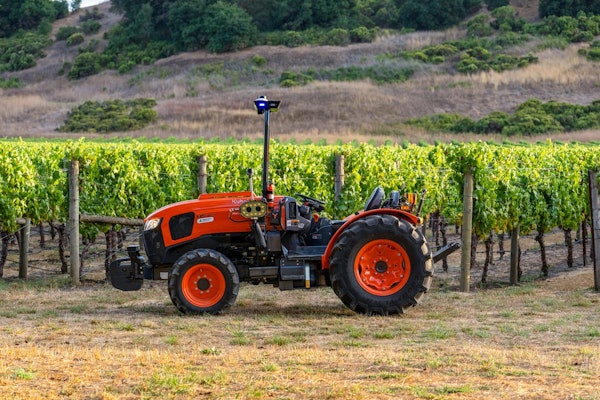 Photo: Wikipedia
Photo: WikipediaOff-season training isn’t just something that athletes can take advantage of during the wintertime.
Just like how athletes need to stay active to remain in peak physical condition, your crews need to be reminded of proper equipment operating techniques and safety practices. Keeping these procedures fresh in their minds will help them kick spring off to a productive start.
“Our spring kick-off training session is key to starting off the season safely,” says Burt DeMarche, president of The LaurelRock Company based in Wilton, Connecticut.
Why it’s important
Bad habits can form over a season (or years) of work and off-season training can serve as a checkup to see if any have developed. By going over proper technique training you can help keep your workers safe and prolong the lifespan of your equipment.
“Improper or aggressive operation greatly contributes to excessive track and undercarriage wear, so teaching operators the proper techniques help prolong component life,” says Buck Storlie, product line manager for ASV Holdings Inc. “Counter-rotations, or sharp changes of direction, cause premature track wear, especially when driving over highly abrasive material, such as shale, granite or ragged materials on demolition sites.”
For handheld equipment, bad habits could include drop starting or throw starting chainsaws or taking the deflectors off of line trimmers.
“The commercial guys want a longer line on it,” says Kenneth Glass, product applications specialist for Stihl. “They don’t realize they’re throwing debris at bystanders and there’s a lot of stuff they don’t take into consideration.”
Off-season training can also serve as a friendly reminder of what personal protective equipment (PPE) needs to be worn for certain tasks. Glass says that eye and hearing protection are often neglected and doing so are violations, according to the Occupational Safety and Health Administration (OSHA).
“Anytime you receive a paycheck, you fall under a professional standard, so they have to wear all that. If not, it’s an OSHA fine,” Glass says.
Topics to cover
One of the prime topics to touch on during off-season training is safety and how to improve upon preventing similar accidents that occurred the previous year.
“We work with our insurance agent to update our safety talk topics in February and take into consideration the types of accidents that we experienced over the last three years when setting priorities,” DeMarche says.
DeMarche says the company focuses refreshers on subjects where injuries were the most frequent.
When Stihl comes to larger landscaping companies’ property to conduct off-season training, Glass says they make a point to remind the landscapers of the OSHA standards and make sure the crews’ PPE is up to date. Helmets, for example, last five years.

A topic that can be easily omitted is equipment operation.
“Proper compact track and skid-steer loader techniques are often overlooked because it’s assumed that anyone can operate one,” Storlie says. “It’s important to stress that, despite how regularly landscapers use the machines and how often the equipment appears on jobsites, proper operating techniques can greatly enhance equipment longevity and uptime.”
Storlie says operators should be encouraged to use three-point turns to avoid causing cuts in the tracks from counter-rotations and refrain from spinning the tracks on abrasive surfaces.
Other less-used pieces of equipment also shouldn’t be forgotten during off-season training, as the lack of familiarity can lead to accidents. Glass says workers tend to pick up concrete saws and try to run them like chainsaws, but the concrete saws have different reactive forces to be aware of.
Also, if your company has just recently purchased new pieces of equipment, training workers before they get out in the field with the new machinery is paramount.
“We purchased battery-operated chainsaws on extension handles last year for our pruning crews,” DeMarche says. “Teaching them the proper way to sharpen and maintain these saws along with safe ways to stand and balance their bodies when using the saws was a crucial part of our early spring training.”
Another element that can be touched on during off-season training is maintenance. Once a worker knows how to properly operate a piece of equipment, knowing how to take care of it will only increase its longevity.
“Neglecting a rubber track can result in a wear life as low as 500 hours,” Storlie says. “To get the longest track life, check track tension and condition daily. Regularly cleaning the undercarriage also lengthens track life since abrasive materials can build up inside, causing wear to the drive lugs and other components.”
Keeping it fresh
If your landscaping company is fortunate enough to have a veteran workforce, this doesn’t mean off-season training isn’t necessary for your crews.
Sometimes simply having an outside company such as Stihl speak to employees can help the training have more weight to it.
“For the veterans, we change the curriculum,” Glass says. “We change the curriculum each time we do the class. I can even speak for repeat classes I’ve done; there’s guys I see every year. We change it up and we build on what we did last year but we still try to keep the basics there for the new people.”
Another way to get veterans to engage during off-season training is to have them lead the safety training sessions. Setting the goal of earning a national safety award can galvanize some veterans into taking the lead on sharing proper techniques.
 Employees competed to blow a tennis ball into a trash can.
Employees competed to blow a tennis ball into a trash can.Photo: LandCare
A popular way of making sure the information has stuck while providing some fun in the mix of training is to incorporate a game towards the end that accumulates everything that was covered.
“I’ve found out most everyone is pretty competitive when you put something in front of them, so that’s how we get the most out of them,” Glass says.
Some of the games Stihl has had landscape workers compete in is a thinest slice competition with chainsaws or a blower competition of blowing an object into a goal.
“Equipment training rodeos are a great way to teach new operators how to properly check, operate and maintain equipment,” DeMarche says. “We took our lead from NALP’s Collegiate Landscape Competition and incorporated the training course they set up for mini-excavator, skid steer and 60” mower operation into our event.”
When LaurelRock’s crews return in the spring for training, DeMarche says the company uses a three-pronged approach of audible, visual and tactile teaching to ensure the safety lessons are retained.
“We mix in videos and hands-on demonstrations to bring the lessons to life,” DeMarche says. “We always provide a translator and handouts are two-sided, printed in both Spanish and English.”









